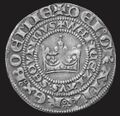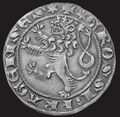Groschen
5ef63059-322e-4e1b-abe8-926e100c770e
Groschen, or Prague Groschen, signified as ![]() , is the currency in Kingdom Come: Deliverance. It was a silver coin used in Bohemia and in many others eastern countries of the Holy Roman Empire.
, is the currency in Kingdom Come: Deliverance. It was a silver coin used in Bohemia and in many others eastern countries of the Holy Roman Empire.
Description
Groschen, Groschen, Groschen. There's lots of dosh in...this big, bad world. Aha, aha. All the things I could buy...
First groschen was minted in April 1300 by King Wenceslas II from 15-lot (93.75%) fine quality silver. This first issue was 3.78 g (officially 3.955 g, 64 pieces from one heavy Prague mark or marca gravis /253.14 g/) with 3.654 g pure silver content. Later both the gross weight and the silver content (silver quantity of the silver alloy) were reduced more times. Just during the reign of Wenceslas IV (1378-1419) it was changed four times. In 1403 the coin weight was 2.626 g (offically 2.665 g, 95 pieces from one 10 11/16-lot (66.79%) heavy Prague mark) with 1.754 g pure silver content. Later in 1407 the silver content was reduced to 1.6 g (9 3/4 lots or 60.94% silver content), while the coin weight remained the same. In 1403 approximately 22 Prague groschens worthed one Hungarian golden florin (forint) which contained 3.5158 g pure gold. From 1407 this ratio was about 24.
Generally in the Middle Ages the silver coins were not so stable currencies than the gold. Both the coin weight and the silver content were changed often by the rulers, and the gold:silver ratio was also fluctuating slightly time to time. But the Prague or Czech groschen relatively was a stable silver currency which was copied by many countries in the region. Originally they were supposed to an 'eternal' use with constant weight and silver quality. But the compensating the cost of their production was always a temptation which regulary led to devaluation of the money. It was a kind of revenue for the royal chambers. But it was hard to follow, and it made the money unreliable in the international use. Different regional silver coins were used mainly in domestic use, while the rarer but constant, stable and reliable gold currencies for the international trade. For comparison at the end of the first 120 years of the Prague groschen its real value reduced to 44%, mainly in the reign of Wenceslas IV, about to the half. It was a benefit for the Crown but ruined the money, the conception of a stable and reliable silver currency, similar to the golden ones.
In the time of our story about 22 of them worth one good Hungarian florin (aranyforint) or 3.5 g 24-carat gold. The price of about 100 kg wheat or a pig.
Gallery
Notes
- The term Groschen was still in use in Austria and parts of Germany until 2002. In Austria it was the official minor currency unit (1 Austrian Schilling = 100 Groschen) until the introduction of the Euro in 2002. In many parts of Germany the term Groschen was coloquially used as a name for the 10 Pfennig coin. That term also fell into disuse after the introduction of the Euro.
de:Groschen pl:Grosz praski



